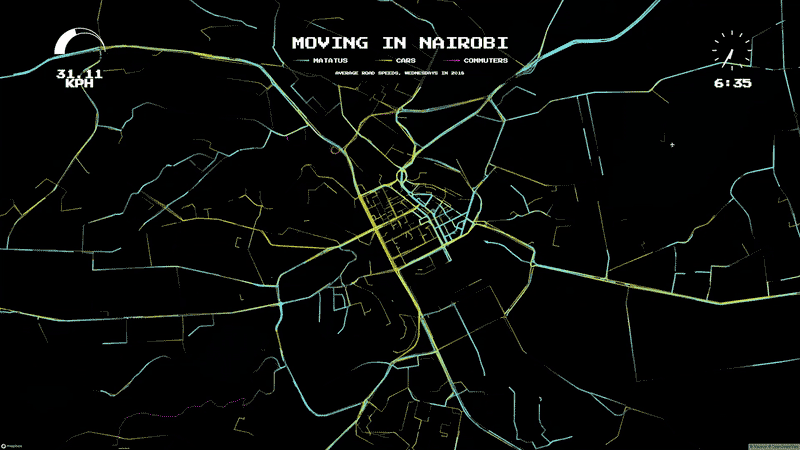"Moving in Nairobi: Stories of Urban Mobility" Exhibited at the 2nd Seoul Biennale of Architecture and Urbanism
February 4, 2020
The "Moving in Nairobi" project was exhibited at the 2nd Seoul Biennale of Architecture and Urbanism under its overarching "Collective City" theme. The exhibition ran from September 7th to November 11th, 2019 at the venues of Dongdaemun Design Plaza (a.k.a. DPP) and Donuimun Museum Village.
Directed by Jaeyong Lim and Francisco Sanin, the 2019 iteration of the Seoul Biennale of Architecture and Urbanism investigates the theme "Collective City", by claiming architecture as an active participant in the construction of the city and as an agent in realizing a political and cultural vision. As the curatorial statement suggests, "the Biennale explores the condition of the collective in the city [...] as a condition to be reclaimed and reframed, suggesting that the collective subject is, in fact, the instrument of political action and transformation of the city".
Within the main theme, the 2019 edition presents four major components: a Thematic Exhibition, Global Studios, Live Projects and a "Cities Exhibition". This last category, curated by Dongwoo Yim and Rafael Luna, exhibits 80 cities around the world, asking creators to look deeper into their most important topics and issues based on the main theme of the Biennale.
Under the "Methods and Speculations" section of the Cities Exhibition, the "Moving in Nairobi" project explores the city of Nairobi, Kenya, from the eyes of four commuters as they walk, ride motorcycles (boda bodas), take buses (matatus) and hire Ubers from the wealthy neighborhoods of this East African capital to the lower-income communities in the city center. The sounds and sights of this rapidly developing city come to life in the exhibition through human-scale portraits, time-lapse videos, newspapers and animated data-visualization with human movement data acquired from Uber and cellphone GPS.
![]()
![]()
![]()
Visitors can experience mobility in Nairobi through the eyes of four residents of Nairobi who wore a Go-Pro video camera as they commuted to and from work. The videos provide a sensory experience of Nairobi’s life. The timelapse videos are displayed on four large screens right in front of the human scale portraits of the four characters.
![]()
The reverse side of portraits hold data visualizations that contextualize Nairobi, a city that has a significant population living in severe poverty. The GPS tracks of the commuters trajectories are both printed on maps and projected on a screen at the entrance of the exhibition, showing Nairobi’s congestion over a 24hr period. This simulated traffic shows the proportion of Ubers, matatus, and private cars on the roadway.
![]()
"Moving in Nairobi" provides visitors with a newspaper that becomes a tool to navigate the exhibition and get familiarity with the city challenging mobility system.
![]()
Directed by Jaeyong Lim and Francisco Sanin, the 2019 iteration of the Seoul Biennale of Architecture and Urbanism investigates the theme "Collective City", by claiming architecture as an active participant in the construction of the city and as an agent in realizing a political and cultural vision. As the curatorial statement suggests, "the Biennale explores the condition of the collective in the city [...] as a condition to be reclaimed and reframed, suggesting that the collective subject is, in fact, the instrument of political action and transformation of the city".
Within the main theme, the 2019 edition presents four major components: a Thematic Exhibition, Global Studios, Live Projects and a "Cities Exhibition". This last category, curated by Dongwoo Yim and Rafael Luna, exhibits 80 cities around the world, asking creators to look deeper into their most important topics and issues based on the main theme of the Biennale.
Under the "Methods and Speculations" section of the Cities Exhibition, the "Moving in Nairobi" project explores the city of Nairobi, Kenya, from the eyes of four commuters as they walk, ride motorcycles (boda bodas), take buses (matatus) and hire Ubers from the wealthy neighborhoods of this East African capital to the lower-income communities in the city center. The sounds and sights of this rapidly developing city come to life in the exhibition through human-scale portraits, time-lapse videos, newspapers and animated data-visualization with human movement data acquired from Uber and cellphone GPS.



Visitors can experience mobility in Nairobi through the eyes of four residents of Nairobi who wore a Go-Pro video camera as they commuted to and from work. The videos provide a sensory experience of Nairobi’s life. The timelapse videos are displayed on four large screens right in front of the human scale portraits of the four characters.

The reverse side of portraits hold data visualizations that contextualize Nairobi, a city that has a significant population living in severe poverty. The GPS tracks of the commuters trajectories are both printed on maps and projected on a screen at the entrance of the exhibition, showing Nairobi’s congestion over a 24hr period. This simulated traffic shows the proportion of Ubers, matatus, and private cars on the roadway.

"Moving in Nairobi" provides visitors with a newspaper that becomes a tool to navigate the exhibition and get familiarity with the city challenging mobility system.
